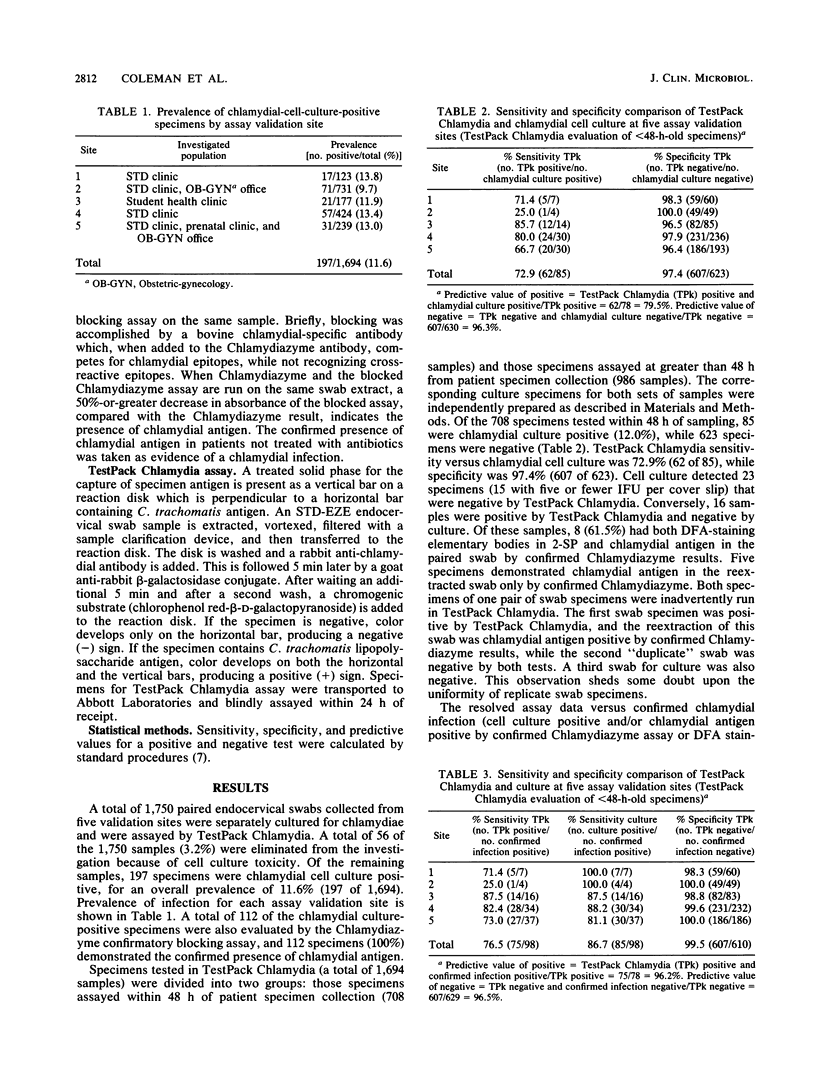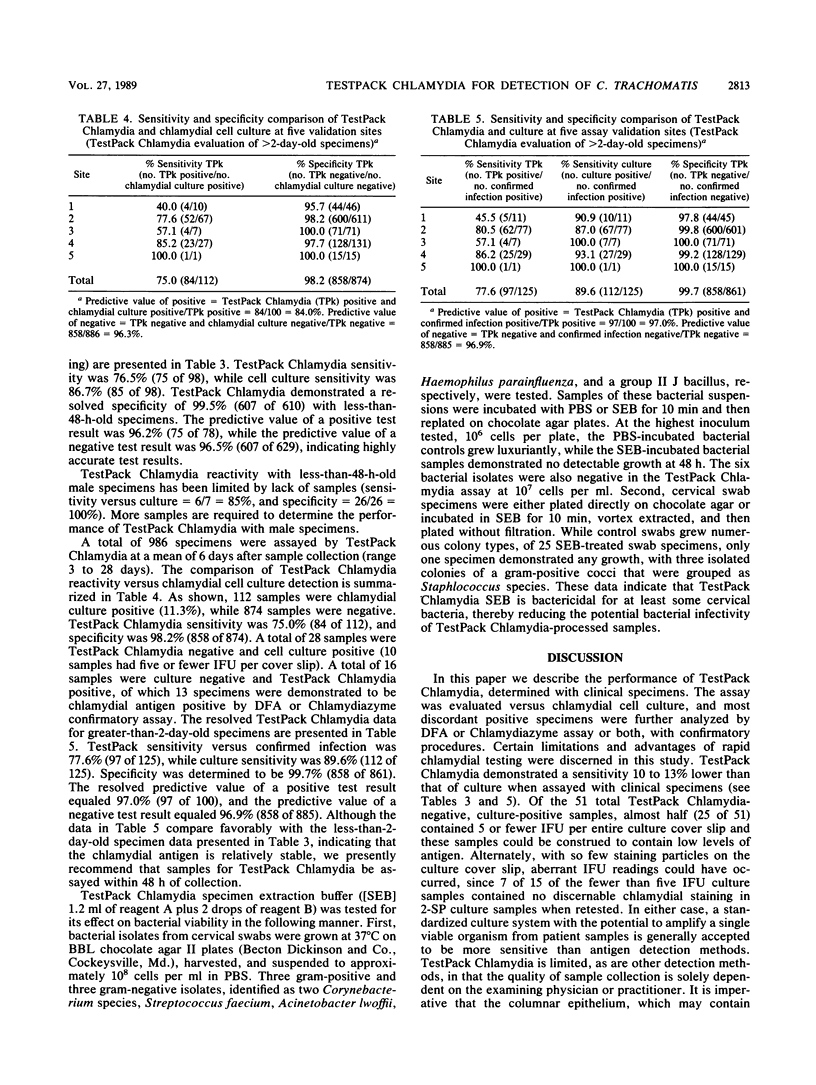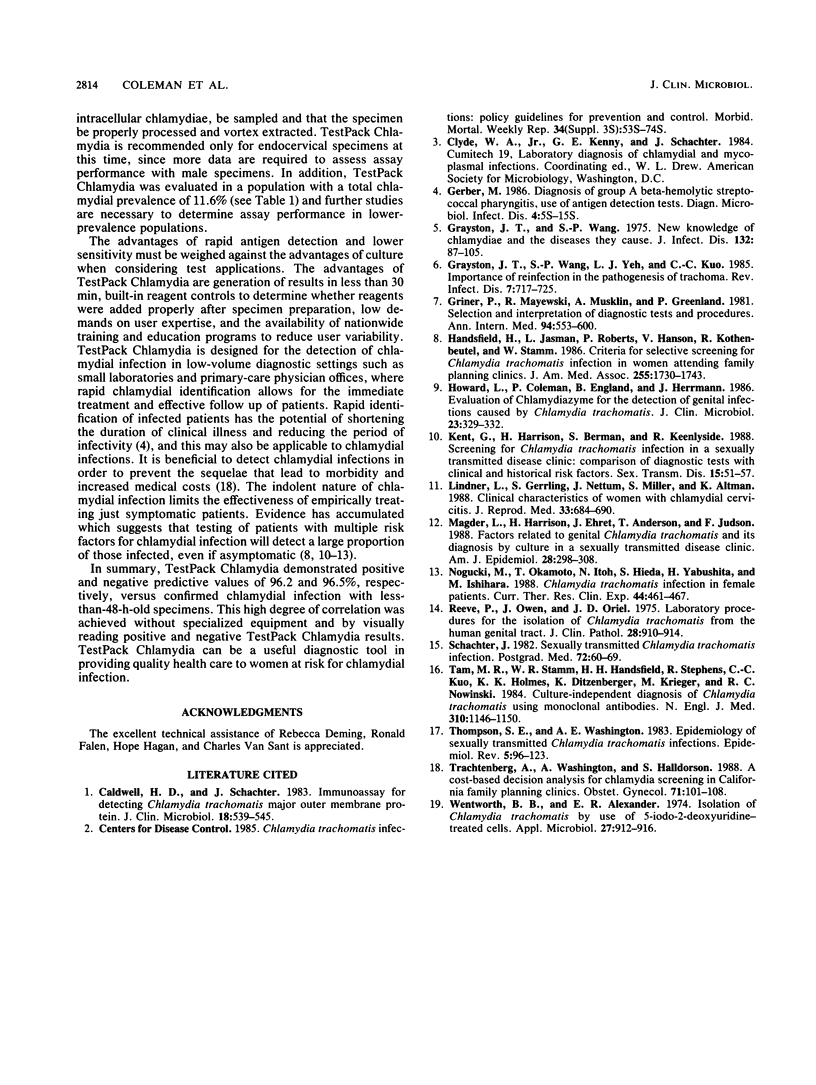Abstract
TestPack Chlamydia (Abbott Laboratories) is a rapid enzyme immunoassay for the direct antigen detection of Chlamydia trachomatis in endocervical specimens. The assay is self-contained, requires no specialized equipment, and yields results in less than 30 min. The clinical performance of TestPack Chlamydia versus chlamydial cell culture was evaluated with a total of 1,694 paired endocervical specimens. Discordant samples were further investigated by immunofluorescent staining and by Chlamydiazyme immunoassay, with confirmatory procedures. The sensitivity of TestPack Chlamydia with less-than-48-h-old specimens was 76.5%, while culture sensitivity was 86.7%. TestPack Chlamydia specificity was determined to be 99.5%. These results indicate that TestPack Chlamydia is an accurate test for chlamydial infection, with a positive predictive value of 96.2%. This assay is suitable for low-volume chlamydial testing in physician offices, clinics, and smaller laboratories.
Full text
PDF



Selected References
These references are in PubMed. This may not be the complete list of references from this article.
- Caldwell H. D., Schachter J. Immunoassay for detecting Chlamydia trachomatis major outer membrane protein. J Clin Microbiol. 1983 Sep;18(3):539–545. doi: 10.1128/jcm.18.3.539-545.1983. [DOI] [PMC free article] [PubMed] [Google Scholar]
- Gerber M. A. Diagnosis of group A beta-hemolytic streptococcal pharyngitis. Use of antigen detection tests. Diagn Microbiol Infect Dis. 1986 Mar;4(3 Suppl):5S–15S. doi: 10.1016/s0732-8893(86)80038-4. [DOI] [PubMed] [Google Scholar]
- Grayston J. T., Wang S. P., Yeh L. J., Kuo C. C. Importance of reinfection in the pathogenesis of trachoma. Rev Infect Dis. 1985 Nov-Dec;7(6):717–725. doi: 10.1093/clinids/7.6.717. [DOI] [PubMed] [Google Scholar]
- Grayston J. T., Wang S. New knowledge of chlamydiae and the diseases they cause. J Infect Dis. 1975 Jul;132(1):87–105. doi: 10.1093/infdis/132.1.87. [DOI] [PubMed] [Google Scholar]
- Handsfield H. H., Jasman L. L., Roberts P. L., Hanson V. W., Kothenbeutel R. L., Stamm W. E. Criteria for selective screening for Chlamydia trachomatis infection in women attending family planning clinics. JAMA. 1986 Apr 4;255(13):1730–1734. [PubMed] [Google Scholar]
- Howard L. V., Coleman P. F., England B. J., Herrmann J. E. Evaluation of chlamydiazyme for the detection of genital infections caused by Chlamydia trachomatis. J Clin Microbiol. 1986 Feb;23(2):329–332. doi: 10.1128/jcm.23.2.329-332.1986. [DOI] [PMC free article] [PubMed] [Google Scholar]
- Kent G. P., Harrison H. R., Berman S. M., Keenlyside R. A. Screening for Chlamydia trachomatis infection in a sexually transmitted disease clinic: comparison of diagnostic tests with clinical and historical risk factors. Sex Transm Dis. 1988 Jan-Mar;15(1):51–57. doi: 10.1097/00007435-198801000-00012. [DOI] [PubMed] [Google Scholar]
- Lindner L. E., Geerling S., Nettum J. A., Miller S. L., Altman K. H. Clinical characteristics of women with chlamydial cervicitis. J Reprod Med. 1988 Aug;33(8):684–690. [PubMed] [Google Scholar]
- Magder L. S., Harrison H. R., Ehret J. M., Anderson T. S., Judson F. N. Factors related to genital Chlamydia trachomatis and its diagnosis by culture in a sexually transmitted disease clinic. Am J Epidemiol. 1988 Aug;128(2):298–308. doi: 10.1093/oxfordjournals.aje.a114970. [DOI] [PubMed] [Google Scholar]
- Reeve P., Owen J., Oriel J. D. Laboratory procedures for the isolation of chlamydia trachomatis from the human genital tract. J Clin Pathol. 1975 Nov;28(11):910–914. doi: 10.1136/jcp.28.11.910. [DOI] [PMC free article] [PubMed] [Google Scholar]
- Schachter J. Sexually transmitted chlamydia trachomatis infection: management of the most common venereal disease. Postgrad Med. 1982 Oct;72(4):60-2, 64, 67 passim. doi: 10.1080/00325481.1982.11716212. [DOI] [PubMed] [Google Scholar]
- Tam M. R., Stamm W. E., Handsfield H. H., Stephens R., Kuo C. C., Holmes K. K., Ditzenberger K., Krieger M., Nowinski R. C. Culture-independent diagnosis of Chlamydia trachomatis using monoclonal antibodies. N Engl J Med. 1984 May 3;310(18):1146–1150. doi: 10.1056/NEJM198405033101803. [DOI] [PubMed] [Google Scholar]
- Thompson S. E., Washington A. E. Epidemiology of sexually transmitted Chlamydia trachomatis infections. Epidemiol Rev. 1983;5:96–123. doi: 10.1093/oxfordjournals.epirev.a036266. [DOI] [PubMed] [Google Scholar]
- Trachtenberg A. I., Washington A. E., Halldorson S. A cost-based decision analysis for Chlamydia screening in California family planning clinics. Obstet Gynecol. 1988 Jan;71(1):101–108. [PubMed] [Google Scholar]
- Wentworth B. B., Alexander E. R. Isolation of Chlamydia trachomatis by use of 5-iodo-2-deoxyuridine-treated cells. Appl Microbiol. 1974 May;27(5):912–916. doi: 10.1128/am.27.5.912-916.1974. [DOI] [PMC free article] [PubMed] [Google Scholar]


